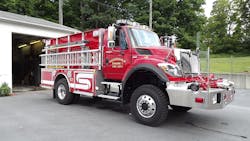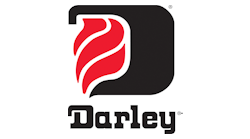Preference Often Dictates Apparatus Fire Pump and Control Locations
There was a time when the front bumper was the preferred location, and just about the only one, for fire pumps on motorized apparatus. Over the decades, pump locations have migrated to various locations on apparatus and now, with the advent of electronic controls, pump control panels can be located virtually anywhere on apparatus.
While pump panels have evolved, the fire industry has settled on midship, between the cab and the body, as the physical location for pumps on modern fire apparatus.
“Midship is the standard location for pumps,” said Jason Darley, North America Sales Manager for W.S. Darley & Co., based in Itasca, IL. “That’s the hallmark of fire trucks today. When we think of fire trucks, we all think of that big silver pump panels in the middle of the truck. That’s the most prevalent location based on statistics.”
Darley said the midship location for pumps is popular with fire departments, whether they choose split-shaft drives from the apparatus drive train or if the pump is PTO-driven with a shaft coming from a gear case.
While the front-mount pump has fallen out of favor with most fire departments, and most pump manufacturers discontinuing the product, the Darley company is the only one in the nation that still offers the product. Darley said front-mount pump remain popular with those who “came up with them” through their careers and appreciate the design.
Front-Mount Pumps Have Fans
“Those who have had them tend to love them,” Darley said. “They are very simple in design. Everything is right out there. You can see it. It’s easy to work on.”
In addition to being accessible and easy to use, Darley said for drafting, the front-mount pump is very convenient. The pump is right on the nose off the apparatus, which can be driven right to a water source and immediately being operations.
Darley said the one big disadvantage of the front-mount pump was the shaft that connects the pump to the apparatus engine was always spinning and the pump could be accidentally engaged, causing catastrophic damage. However, the Darley company designed a shock control module many years ago that prevents accidental front-mount pump engagement.
The company has also addressed the issue with exposed front-mount pumps freezing in cold climates. Darley said the company has an open-loop void in the casing of its pump that serves as a heater core connected to the apparatus engine to keep the pump warm in the cold weather and the engine cooler in hot temperatures.
Darley said the front-mount pump isn’t for every department, but he is pleased his namesake company is the only one in the nation to offer the option.
At Hale Products, a pump-maker in Ocala, FL, front-mount pumps were discontinued about four or five years ago, according to the company’s product strategy manager, Jeff Van Meter. He said the market shifted to mid-ship mounted pumps and the demand fell off precipitously.
“The reason for that is we figured out a better way to power a pump,” Van Meter said, noting that the crankshaft power connection wasn’t the best way to power a pump, especially as they grew in capacity to in excess of 2,000 gpm.
Van Meter said front-mount pumps leave a lot of hardware and plumbing exposed on the front of the apparatus, vulnerable to expensive damage in front-end collisions.
There is still an advantage of having the ability to draft from the front of an apparatus, and many truck builders offer front-mount suctions on the bumper, Van Meter said, noting the design offers one of the big advantages of front-mount pumps without the risk of damage.
Mid-Ship Pumps Are Favored
Van Meter agreed with Darley in the assessment that most fire apparatus in the United States have mid-mount fire pumps. With pump modules that truck builders can purchase as complete fire suppression kits, 90 percent of the units built by Hale are mid-mounts with 90 percent of those equipped with side-mount controls and 10 percent with top-mount controls.
Unlike the situation in the United States, rear-mount pumps are the standard throughout most of the world, Van Meter said. Apparatus with rear-mount pumps tend to be more compact and have shorter wheelbases, he added, noting that those features are particularly advantages for European communities with narrow streets in tight urban areas.
Many fire departments in the United States have come to the conclusion that having operators at the rear of apparatus is too much of a risk, Van Meter said. When crashes happen, it’s often caused by motorists slamming into the rear of fire trucks, he said.
“If you look at highway safety, it doesn’t make sense to have firefighters directly at the back of the truck,” Van Meter said. “When there are accidents, it’s usually the back of the truck that gets hit. It just doesn’t offer enough protection for highway safety.” He said rear-mount pumpers are sometimes specified by very rural departments that don’t have to worry much about traffic and want some of the advantages offered by the specification, including more compartment space and a shorter overall apparatus length.
Some metropolitan areas in the United States have vacillated between rear-mount pumps and mid-mount pumps, said Gregg Geske, director of sales for North America at Waterous Company, a pump-maker based in South St. Paul, MN. The debate is always operator safety verses compact designs, he said.
“When it comes to pump locations, it always comes down to personal preferences,” Geske said.
PTO-Driven Pumps Gain Popularity
Another preference Van Meter said he’s been seeing lately is for PTO-driven pumps.
“They can be placed pretty much anywhere,” Van Meter said, noting that the majority are still placed in the mid-ship location to get good driveline alignment and function.
PTO-driven pumps can be “tucked” under cabs or apparatus bodies to offer more compartment space, Van Meter said. But PTO-driven pumps are generally limited to 1,500-gpm flow rates, which is sufficient for fire-rated apparatus, but leaves no reserve capacity, he said.
“When we sell pumps, we like to push people into bigger pumps,” Van Meter said. “They’ll have more capacity as they wear down.” He said clearance rings and other moving parts can wear in pump operations and having additional capacity will mean that in five years or more of service, the pump will still sustain rated flow rates without major overhauls and repairs.
“It works as a buffer,” he said.
Darley said in the 11 years he’s been working for the family-owned company, he has seen significant increases in the demand for PTO-driven pumps. That demand, he said, “comes down to our ability to package things” and the versatility afforded by PTO pumps.
Today, apparatus are multi-function vehicles and have different response capabilities, Darley said. On average, large fire pumps are only needed in 4 to 6 percent of the responses, he added, noting that it makes little sense to dedicate up to 20 percent of the overall apparatus length to a component that is so infrequently used. A PTO-driven pump gives departments 1,500-gpm fire flows, affording the necessary points toward improved Insurance Services Office (ISO) ratings.
Mid-ship pumps afford the best location for safety, not exposing firefighters to possible impacts during front or rear collisions and offer the best alignments for power and drive shafts. Typically, control panels have to be located near, and aligned with the pumps so mechanical levers and controls can operate smoothly.
Electronic-Control Equals Freedom
Whereas the best location for the physical pump may be limited, electronic controls means pump panels can be located virtually anywhere, experts said.
Van Meter said the industry is seeing a lot more apparatus with electronic pump controls, including pressure relief systems, which are controlled by engine governors. And that’s a good thing, he said, because many new recruits don’t have the same level of mechanical skills as older generations of firefighters and automatic systems controlled electronically are inherently safer.
“That’s where electronics come in,” Van Meter said. “If you’ve got a firefighter working a scene in the 11th hour of a 12-hour shift, and he’s tired, he doesn’t have to think about everything.”
Darley said the overall trend is for electronic pump controls as the product matures and has won over skeptical firefighters who don’t think the words “electronics” and “water” belong in the same sentence, never mind on the apparatus.
With electronic controls, the position of pump control panels “is now limitless,” Darley said. “You can have them over the rear wheels, on the side, up top, even inside the cabs.”
But with that freedom comes the cautionary advice of Van Meter, who said fire department have to remember that pump maintenance should always be considered when specifying apparatus.
It may be possible to tuck a pump deep behind cabinets or under a cab because it no longer needs straight line, mechanical control levers, but accessibility should be maintained.
“It should be an overarching principal,” Darley said. “There is a potential to jamb pumps where the specification require, but if it’s not accessible, it could take a lot of hours to maintain and that equals costs. … Certainly simplicity ought to be considered in your pumper design.”
Geske said electronics controls can also mean smaller control panels, creating more compact apparatus. It can also be used to create curb-side keeping pump panels, keeping firefighters out of traffic.
Electronics also means that touch-screen tablets can be used to control pumps, giving pump operators the ability to move about and pick the location for the best operation, Geske said.
With that freedom comes some risk, Geske cautioned. While the pump location and control can vary widely, Geske said there’s only one place for the operator and that’s in front of the panel.
“I don’t want my pump operators walking around checking smoke conditions,” Geske said. “I want them right in front of the pump, doing their jobs.”









